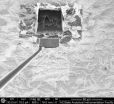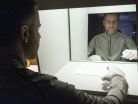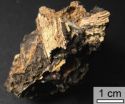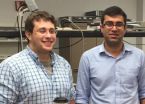(Press-News.org) ITHACA, N.Y. – Researchers from Cornell University and Brookhaven National Laboratory have shown how to switch a particular transition metal oxide, a lanthanum nickelate (LaNiO3), from a metal to an insulator by making the material less than a nanometer thick.
Ever-shrinking electronic devices could get down to atomic dimensions with the help of transition metal oxides, a class of materials that seems to have it all: superconductivity, magnetoresistance and other exotic properties. These possibilities have scientists excited to understand everything about these materials, and to find new ways to control their properties at the most fundamental levels.
Image: https://cornell.box.com/perovskite
The team of researchers, which published its findings online April 6 in Nature Nanotechnology (to appear in the journal's May issue), includes lead researcher Kyle Shen, associate professor of physics; first author Phil King, a recent Kavli postdoctoral fellow at Cornell now on the faculty at the University of St. Andrews; Darrell Schlom, the Herbert Fisk Johnson Professor of Industrial Chemistry; and co-authors Haofei Wei, Yuefeng Nie, Masaki Uchida, Carolina Adamo, and Shabo Zhu, and Xi He and Ivan Božović.
Using an extremely precise growth technique called molecular-beam epitaxy (MBE), King synthesized atomically thin samples of the lanthanum nickelate and discovered that the material changes abruptly from a metal to an insulator when its thickness is reduced to below 1 nanometer. When that threshold is crossed, its conductivity – the ability for electrons to flow through the material – switches off like a light, a characteristic that could prove useful in nanoscale switches or transistors, Shen said.
Using a one-of-a-kind system at Cornell, which integrates MBE film growth with a technique called angle-resolved photoemission spectroscopy (ARPES), King and colleagues mapped out how the motions and interactions of the electrons in the material changed across this threshold, varying the thickness of their oxide films atom by atom. They discovered that when the films were less than 3 nickel atoms thick, the electrons formed an unusual nanoscale order, akin to a checkerboard.
The results demonstrate the ability to control the electronic properties of exotic transition metal oxides at the nanometer scale, as well as revealing the striking cooperative interactions that govern the behavior of the electrons in these ultrathin materials. Their discovery paves the way for making advanced new electronic devices from oxides.
INFORMATION:
The work was supported by the Kavli Institute at Cornell for Nanoscale Science, the Office of Naval Research, the National Science Foundation through the Cornell Center for Materials Research (MRSEC program), and the U.S. Department of Energy, Basic Energy Sciences.
Cornell University has television, ISDN and dedicated Skype/Google+ Hangout studios available for media interviews. For additional information, see this Cornell Chronicle story.
'Exotic' material is like a switch when super thin
2014-04-18
ELSE PRESS RELEASES FROM THIS DATE:
New study suggests a better way to deal with bad memories
2014-04-18
What's one of your worst memories? How did it make you feel? According to psychologists, remembering the emotions felt during a negative personal experience, such as how sad you were or how embarrassed you felt, can lead to emotional distress, especially when you can't stop thinking about it.
When these negative memories creep up, thinking about the context of the memories, rather than how you felt, is a relatively easy and effective way to alleviate the negative effects of these memories, a new study suggests.
Researchers at the Beckman Institute at the University ...
Impurity size affects performance of emerging superconductive material
2014-04-18
Research from North Carolina State University finds that impurities can hurt performance – or possibly provide benefits – in a key superconductive material that is expected to find use in a host of applications, including future particle colliders. The size of the impurities determines whether they help or hinder the material's performance.
At issue is a superconductive material called bismuth strontium calcium copper oxide (Bi2212). A superconductor is a material that can carry electricity without any loss – none of the energy is dissipated as heat, for example. Superconductive ...
Innovative strategy to facilitate organ repair
2014-04-18
This news release is available in French. A significant breakthrough could revolutionize surgical practice and regenerative medicine. A team led by Ludwik Leibler from the Laboratoire Matière Molle et Chimie (CNRS/ESPCI Paris Tech) and Didier Letourneur from the Laboratoire Recherche Vasculaire Translationnelle (INSERM/Universités Paris Diderot and Paris 13), has just demonstrated that the principle of adhesion by aqueous solutions of nanoparticles can be used in vivo to repair soft-tissue organs and tissues. This easy-to-use gluing method has been tested on rats. When ...
Under some LED bulbs whites aren't 'whiter than white'
2014-04-18
For years, companies have been adding whiteners to laundry detergent, paints, plastics, paper and fabrics to make whites look "whiter than white," but now, with a switch away from incandescent and fluorescent lighting, different degrees of whites may all look the same, according to experts in lighting.
"Retailers have long been concerned with the color-rendering qualities of their lighting, but less aware how light sources render white," said Kevin W. Houser, professor of architectural engineering, Penn State.
Not long ago, the only practical choices for home, office ...
Frozen in time: 3-million-year-old landscape still exists beneath the Greenland ice sheet
2014-04-18
Some of the landscape underlying the massive Greenland ice sheet may have been undisturbed for almost 3 million years, ever since the island became completely ice-covered, according to researchers funded by the National Science Foundation (NSF).
Basing their discovery on an analysis of the chemical composition of silts recovered from the bottom of an ice core more than 3,000 meters long, the researchers argue that the find suggests "pre-glacial landscapes can remain preserved for long periods under continental ice sheets."
In the time since the ice sheet formed "the ...
Impact glass stores biodata for millions of years
2014-04-18
PROVIDENCE, R.I. [Brown University] — Asteroid and comet impacts can cause widespread ecological havoc, killing off plants and animals on regional or even global scales. But new research from Brown University shows that impacts can also preserve the signatures of ancient life at the time of an impact.
A research team led by Brown geologist Pete Schultz has found fragments of leaves and preserved organic compounds lodged inside glass created by a several ancient impacts in Argentina. The material could provide a snapshot of environmental conditions at the time of those ...
'Dressed' laser aimed at clouds may be key to inducing rain, lightning
2014-04-18
The adage "Everyone complains about the weather but nobody does anything about it," may one day be obsolete if researchers at the University of Central Florida's College of Optics & Photonics and the University of Arizona further develop a new technique to aim a high-energy laser beam into clouds to make it rain or trigger lightning.
The solution? Surround the beam with a second beam to act as an energy reservoir, sustaining the central beam to greater distances than previously possible. The secondary "dress" beam refuels and helps prevent the dissipation of the high-intensity ...
First Earth-size planet is discovered in another star's habitable zone
2014-04-18
A team of astronomers that includes Penn State scientists has discovered the first Earth-size planet orbiting a star in the "habitable zone" -- the distance from a star where liquid water might pool on the surface of an orbiting planet. The discovery was made with NASA's Kepler Space Telescope. The discovery of this Earth-size planet, now named Kepler-186f, confirms -- for the first time -- that planets the size of Earth exist in the habitable zone of stars other than our Sun.
Some planets previously had been found in the habitable zone, but they all were at least 40 ...
Scientists discover brain's anti-distraction system
2014-04-18
Two Simon Fraser University psychologists have made a brain-related discovery that could revolutionize doctors' perception and treatment of attention-deficit disorders.
This discovery opens up the possibility that environmental and/or genetic factors may hinder or suppress a specific brain activity that the researchers have identified as helping us prevent distraction.
The Journal of Neuroscience has just published a paper about the discovery by John McDonald, an associate professor of psychology and his doctoral student John Gaspar, who made the discovery during his ...
New research shows people are thinking about their health early in the week
2014-04-18
San Diego, Calif. (April 18, 2014) ― A new study in the American Journal of Preventive Medicine analyzing weekly patterns in health-related Google searches reveals a recurring pattern that could be leveraged to improve public health strategies.
Investigators from San Diego State University, the Santa Fe Institute, Johns Hopkins University, and the Monday Campaigns, analyzed "healthy" Google searches (searches that included the term healthy and were indeed health-related, e.g., "healthy diet") originating in the U.S. from 2005 to 2012. They found that on average, ...







